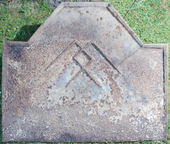-
1122
Description: Plain rectangular plate with cyma reversa, or ogee, moulding on top and sides.
Notes: A base board without other decoration. Other firebacks may have been cast using it.
- Decoration tags:
- rectangular (shape)
- cyma reversa/ogee (edging)
- carved pattern panels
Manufactured: in the 17th century in England.
Current location: 10 Garden Street, Accrington, Lancashire, England.
- Attached to series:
- Base boards
-
379
Description: Rectangular; single moulded edge on top and sides; bold date and initials, formed from large individual characters, on same line across full width of plate; otherwise plain. Side lifting lug on top right.
Notes: The style of the numerals, particularly the 6 and 5, can be seen on a smaller fireback of 1656. Lifting handles are only seen on a few firebacks. Formerly part of the J. H. Every collection.
Inscription: 1653 IHA
- Decoration tags:
- rectangular (shape)
- rebated fillet (edging)
- carved stamps
- individual letters
- individual numbers
- lifting handles
- text
Manufactured: in 1653 in the Weald area of England.
Current location: Anne of Cleves House, Southover High Street, Lewes, East Sussex, England.
Museum number: 1944.24.044 (part of the Sussex Archaeological Society museum group)
- Attached to series:
- Lifting handle firebacks
- 1650s Wealden series
-
465
Description: Rectangular with three-faced arch; ogee moulded edging; top centre, overlapping, crossed staples arranged diagonally, each pointing to a bottom corner.
Notes: The crossed staple is the badge of the Nevill family, and this fireback came from Eridge Park, the seat of the Marquess of Abergavenny.
- Decoration tags:
- rectangular with three-facetted arch (shape)
- cyma reversa/ogee (edging)
- simple stamps
- heraldic
- objects
Manufactured: in the 18th century possibly in the Weald area of England.
Current location: in private hands, Little Horsted, East Sussex, England.
- Attached to series:
- Personal firebacks
- Metalware stamp firebacks
-
733
Description: Rectangular with canted top corners and a triangular extension from the top edge; twisted rope edges to all sides except bottom; a circular wafering iron or butter mould stamp, incorporating a square design with a fleur-de-lys on each side, repeated thrice, one at the apex and one below each of the canted corners; two inverted ‘V’ rope shapes overlapping to make an ‘M’ below top stamp.
Notes: The inverted double 'V' may be apotropaic, invoking the protection of the Virgin Mary; the circular stamp has also been noted on a Pelham-associated fireback of 1642 (no. 1204) which may suggest that it was a product of one of the family's ironworks.
- Decoration tags:
- rectangular with triangular arch (shape)
- rope (edging)
- simple stamps
- apotropaic
- objects
Manufactured: in the late-16th to early-17th century possibly at Waldron Furnace in the Weald area of England.
Current location: Victoria & Albert Museum, Cromwell Road, Kensington & Chelsea, Greater London, England.
Museum number: 895.1901 (part of the Victoria & Albert Museum museum group)
Citation: Page, S. & Wallace, M. (eds.), 2018, Spellbound (Oxford, Ashmolean Museum), p. 72.
- Attached to series:
- Food mould stamp firebacks
- Rope design firebacks



